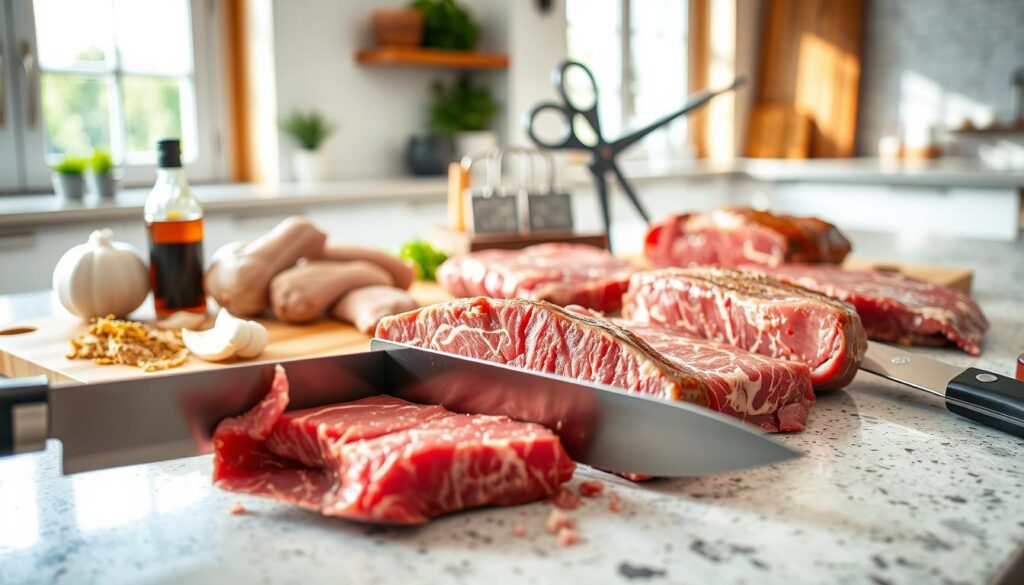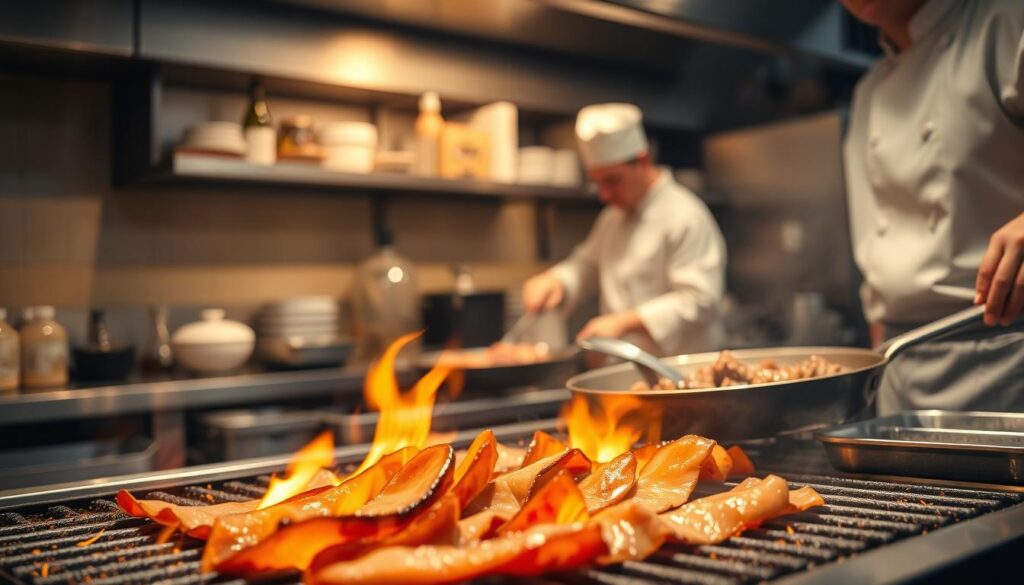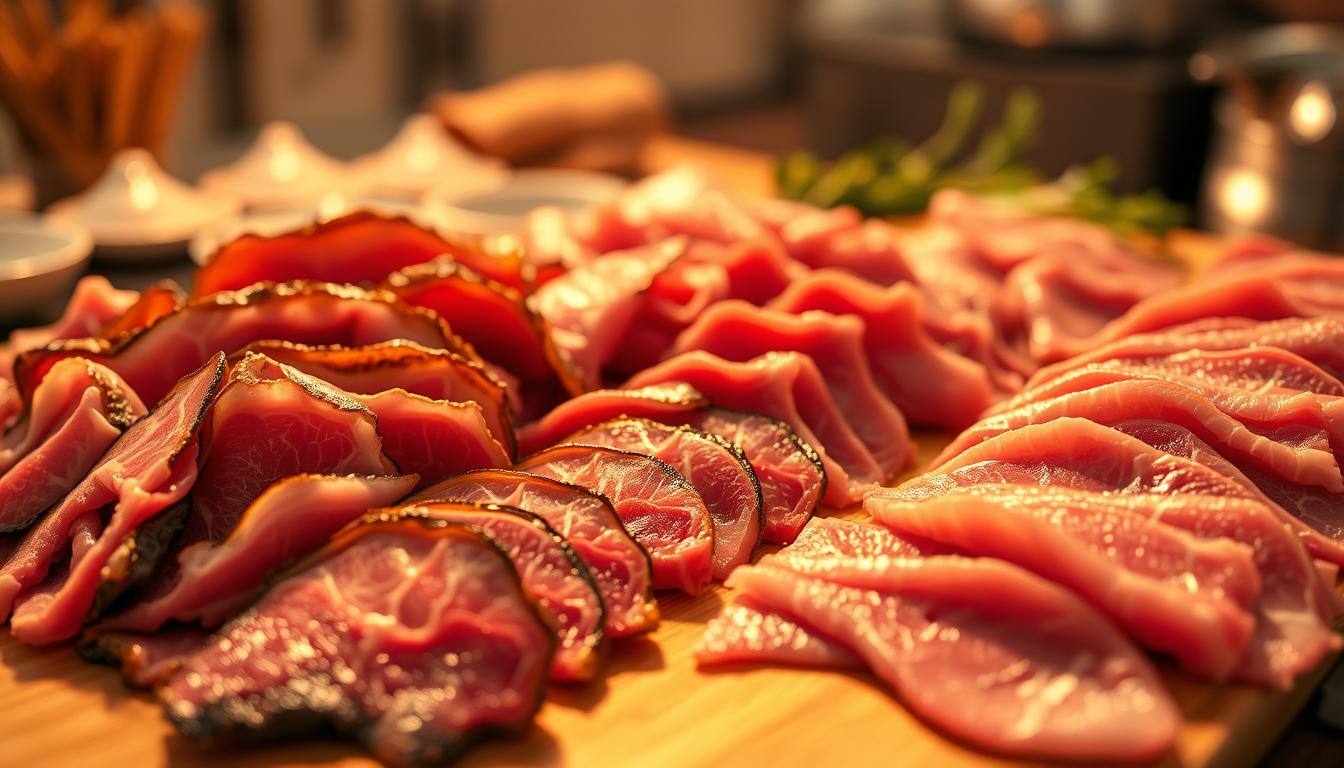Imagine the aroma of sizzling meat on a grill, the flavors dancing on your palate. This is bulgogi, a traditional Korean dish that has captured hearts worldwide. Fire meat, as it’s often called, is more than just a meal—it’s an experience.
Originating in the Goguryeo era, bulgogi has evolved over centuries, blending tradition with modern tastes. The dish typically features thinly sliced beef, marinated in a sweet and savory sauce, creating a harmonious balance of flavors.
At the heart of a great bulgogi lies the quality of the meat. The right cut of beef can elevate the dish from ordinary to extraordinary. Factors like marbling and tenderness are crucial, ensuring each bite is juicy and flavorful.
In The Essential Guide to Choosing the Best Meat for Bulgogi, we’ll explore the essential criteria for selecting the perfect meat for your bulgogi. We’ll delve into expert tips, from choosing the right cuts to mastering marinades and cooking techniques. Whether you’re a novice or a seasoned chef, this guide will help you create an authentic Korean BBQ experience at home.
So, let’s embark on this culinary journey together. Discover how to make your bulgogi truly unforgettable, with both classic and creative twists that will delight your senses.
Introduction to Korean Bulgogi
Bulgogi, which translates to “fire meat,” is a beloved Korean dish that has gained worldwide popularity. This iconic Korean BBQ dish is known for its sweet and savory flavors, making it a staple at gatherings and celebrations.
Understanding Bulgogi’s Heritage
Bulgogi has deep roots in Korean history, dating back to the Goguryeo era. Over time, it evolved into a dish that blends tradition with modern tastes. The marinade, typically made with soy sauce, sugar, garlic, and sesame oil, gives the meat its distinctive flavor. These ingredients are essential in creating the dish’s signature taste.
Why Bulgogi is a Beloved Korean Dish
Bulgogi’s popularity stems from its rich, balanced flavor profile. The use of high-quality ingredients like tender steak cuts ensures each bite is juicy and flavorful. Regional variations have emerged, but the core elements remain the same. The dish is a testament to Korean culinary art, with its marinade being a key factor in its appeal.
Understanding Different Cuts of Beef for Bulgogi
Choosing the right cut of beef is crucial for a delicious bulgogi. Each cut offers unique qualities that can elevate your dish.
Recognizing Tender and Marbled Cuts
Tender and marbled cuts are ideal for bulgogi. Marbling adds flavor and tenderness, ensuring a juicy texture. Look for cuts with even fat distribution for the best results.
Top Sirloin, Rib Eye, and More
Top sirloin and rib eye are popular choices. Top sirloin is lean yet tender, while rib eye is richer with more marbling. Both cuts are great for bulgogi when sliced thinly.
| Cut | Marbling | Tenderness | Slice Thickness | Cooking Suitability |
|---|---|---|---|---|
| Top Sirloin | Moderate | Tender | Thin | Excellent |
| Rib Eye | High | Very Tender | Thin | Excellent |
| Beef Tenderloin | Low | Most Tender | Thin | Good |
Thinly sliced beef allows the marinade to infuse fully, enhancing flavor during cooking. Quality ingredients are key to a great bulgogi experience.
Choosing the Best Meat for Bulgogi
When it comes to crafting an authentic bulgogi experience, the quality of your ingredients is paramount. Selecting the right meat is the first step toward a dish that delights the senses.
What to Look for in Quality Meat
A high-quality cut of beef should have a vibrant red color and even marbling. These traits ensure tenderness and flavor. Opt for cuts like top sirloin or rib eye, which balance marbling and texture perfectly.
| Cut | Color | Marbling | Texture |
|---|---|---|---|
| Top Sirloin | Vibrant Red | Moderate | Tender |
| Rib Eye | Deep Red | High | Velvety |
| Beef Tenderloin | Bright Red | Low | Buttery |
The marinade plays a dual role: it flavors and tenderizes the meat. Ingredients like garlic, pepper, onion, and green onion add depth and zest. As noted by a culinary expert, “A well-crafted marinade can elevate even the simplest cut of beef.”
Inspect the meat for firmness and freshness. A fresh cut will have a slight bounce when pressed. Visit your local butcher to ensure you’re selecting the best available options.
Preparing Your Meat: Cutting Techniques and Tips
Proper preparation is the cornerstone of a successful bulgogi dish. Taking the time to prep your ingredients ensures a flavorful and visually appealing meal. In this section, we’ll guide you through the essential steps to prepare your beef for bulgogi, focusing on cutting techniques and timing.
Step-by-Step Guide to Thinly Slicing
To achieve thin, uniform slices, start by placing the beef in the freezer for about 10 minutes. This firms the meat, making it easier to slice evenly. Use a sharp knife and slice against the grain to ensure tenderness. If the meat doesn’t slice easily, allow it a few more minutes in the freezer to firm up further.
Tools and Timing for Perfect Cuts
Sharpen your knife before slicing to prevent tearing the meat. Invest in a meat slicer for consistency, or use a mandoline if you prefer. Allocate about 15 minutes for slicing, ensuring each piece is thin enough to absorb the marinade fully. A food prep glove will protect your hand while slicing, adding to your safety in the kitchen.

Timing is crucial in the kitchen. Allowing the meat to rest after slicing helps retain its juices. If you’re prepping ahead, store the slices in an airtight container to maintain freshness. Remember, careful preparation is key to a delicious bulgogi experience.
Marinating for Maximum Flavor and Tenderness
Marinating is the heart of bulgogi preparation, transforming ordinary beef into a dish packed with flavor and tenderness. Each ingredient in the marinade plays a vital role, contributing to the overall taste and texture of the meat.
Key Marinade Ingredients and Their Roles
A well-crafted marinade combines sweetness, savory notes, and tenderizers. Sugar is essential for caramelization, creating a rich, savory crust during cooking. Sesame oil adds a nutty aroma, while rice components like rice wine balance acidity, enhancing the marinade’s depth.
| Ingredient | Role | Benefit |
|---|---|---|
| Sugar | Caramelization | Rich, savory crust |
| Sesame Oil | Nutty Aroma | Enhances flavor depth |
| Rice Components | Acidity Balance | Smooth flavor profile |
| Pear | Tenderization | Ensures juicy texture |
Using Pear, Apple, and Other Tenderizers
Pear is a traditional tenderizer, breaking down proteins for a tender texture. If pear isn’t available, apple makes a great substitute. Both add natural sweetness and tenderize the meat effectively, ensuring each bite is juicy and flavorful.
Cooking Techniques: Grilling and Pan Frying Bulgogi
Cooking bulgogi is an art that brings out the best in your ingredients. Whether you prefer the smoky flavor of a grill or the convenience of a skillet, the right technique ensures a delicious outcome.
Benefits of Charcoal and Pan Cooking
Grilling over charcoal adds a unique smokiness that enhances the dish’s flavor. A preheated grill ensures even cooking, while a skillet offers control over temperature and texture. Both methods allow for a nice sear, caramelizing the sugars in the marinade.
Temperature Tips for Sizzling Results
For grilling, maintain a medium-high heat (around 375°F). In a skillet, preheat it to 400°F before adding oil. Cook the beef for 3-4 minutes per side. Use a teaspoon of oil to prevent sticking without overpowering the marinade.
| Method | Equipment | Heat Source | Texture |
|---|---|---|---|
| Grilling | Charcoal Grill | Medium-High | Smoky, Charred |
| Pan Frying | Skillet | High Heat | Crispy, Caramelized |
Don’t overcrowd the pan; cook in batches if necessary. This ensures each piece sears properly. Adjust cooking times based on the beef’s thickness for perfectly tender results.

Enhancing Flavor with Sauces and Accents
Elevate your bulgogi to new heights by incorporating flavorful sauces and accents that add depth and complexity to each bite. The right balance of ingredients can transform your dish into a culinary masterpiece.
Incorporating Soy Sauce, Sesame Oil, and More
Soy sauce and sesame oil are staples in Korean cuisine, each playing a vital role in enhancing the flavor profile. Soy sauce adds a savory depth, while sesame oil contributes a nutty aroma. Start with a base marinade using a cup of soy sauce and a tablespoon of sugar to balance sweetness and savory notes.
Sesame seeds are another key ingredient, offering a satisfying crunch and nutty flavor. Sprinkle them generously as a finishing touch for added texture. A tablespoon of sesame oil can also be added during cooking to infuse a rich aroma without overpowering the dish.
- Begin with a base marinade using a cup of soy sauce and a tablespoon of sugar.
- Add a tablespoon of sesame oil for an aromatic boost.
- Sprinkle sesame seeds generously as a finishing touch.
- Adjust the level of sweetness by adding a tablespoon of sugar to taste.
Layering flavors is crucial for a harmonious final dish. Experiment with these ingredients while maintaining the traditional balance that makes bulgogi so beloved. With precise measurements and a focus on quality, your bulgogi will be nothing short of extraordinary.
Creative Bulgogi Variations to Try at Home
Looking to shake up your bulgogi routine? Try these creative twists that blend tradition with modern flavors. Whether you’re a vegetarian or a meat lover, these ideas will inspire you to think outside the box.
Exploring Vegetarian Alternatives
Vegetarian bulgogi is gaining popularity, and for good reason. Marinated mushrooms, especially shiitake or portobello, make an excellent substitute for beef. They absorb flavors beautifully and offer a hearty texture. For the best results, marinate them for at least 2-3 hours to allow the flavors to meld.
Add some crunch with sesame seeds. Sprinkle them over your dish before serving for a nutty flavor and satisfying texture. This simple addition can elevate your vegetarian bulgogi to the next level.
Adapting Traditional Recipes for Modern Palates
Modern twists on bulgogi can cater to diverse tastes. For instance, you can adjust the spice level by adding more gochujang for a fiery kick or substitute beef with chicken or tofu for a different protein option. These changes make the dish more versatile while keeping its core flavors intact.
- Marinate mushrooms for 2-3 hours to enhance flavor absorption.
- Use sesame seeds as a topping for added texture and nutty flavor.
- Experiment with spice levels to suit your taste preferences.
- Try alternative proteins like chicken or tofu for a fresh twist.
When serving, consider pairing your bulgogi with unique sides like kimchi coleslaw or pickled vegetables. These combinations can add a refreshing contrast to the rich flavors of the dish. Whether you’re serving a crowd or enjoying a quiet meal, these variations ensure there’s something for everyone.
Pairing Bulgogi with Authentic Korean Sides
Creating a well-rounded bulgogi meal involves more than just the main dish. The right side dishes can elevate your dining experience, adding layers of flavor and texture. Let’s explore some classic Korean sides that perfectly complement bulgogi.
Serving Recommendations and Side Dishes
Korean cuisine is known for its balance of flavors and textures. When serving bulgogi, consider pairing it with sides that offer contrast and harmony. Here are some traditional options:
Kimchi is a staple in Korean meals. This spicy fermented cabbage adds a bold, tangy flavor that cuts through the richness of the grilled meat. Its crunchy texture provides a delightful contrast to the tender beef.
For a lighter option, steamed rice is a perfect complement. It soaks up the savory juices of the bulgogi, ensuring no flavor goes to waste. A small bowl of rice on the side helps balance the meal.
Lettuce wraps are another popular choice. Crisp lettuce leaves provide a fresh, herbaceous note. Simply place a slice of bulgogi in the center of a lettuce leaf, add a sprinkle of kimchi, and wrap it up for a flavorful bite.
Other sides like pickled radishes or steamed vegetables offer a refreshing contrast. These mild options provide a nice break from the bold flavors of the main dish.
When plating, consider the visual appeal. Arrange the bulgogi on a large platter or individual plates, surrounded by small bowls of side dishes. This not only looks appealing but also makes the meal feel more authentic.
Remember, the key to a great bulgogi meal is variety. Mix spicy and mild sides to cater to different tastes. Experiment with various textures and flavors to create a dish that’s both satisfying and visually appealing.
Conclusion
Creating an unforgettable bulgogi experience involves careful selection of ingredients, precise preparation, and attention to detail. From choosing the right cuts of beef to mastering marinades and cooking techniques, each step plays a role in crafting a dish that delights the senses.
To ensure your bulgogi remains flavorful and fresh, store leftovers in an airtight container and refrigerate within two hours of cooking. This helps maintain quality and safety. For longer storage, consider freezing the meat, which preserves texture and flavor for up to three months.
When preparing your meal, be mindful of sodium intake. Opt for low-sodium soy sauce and balance flavors with natural sweeteners like pear or apple. This approach keeps your dish nutritious while maintaining its signature taste.
With these tips, you’re ready to create an authentic Korean BBQ experience at home. Revisit this guide, experiment with new variations, and enjoy the journey of mastering bulgogi. Gather your loved ones, savor the flavors, and make every meal a memorable one.

